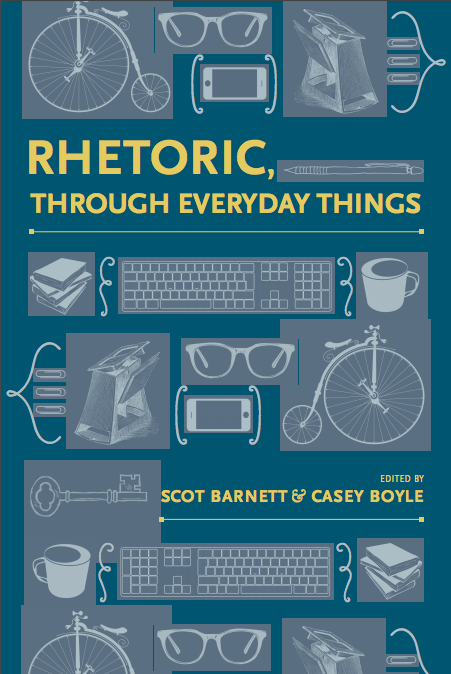Rhetoric, Through Everyday Things
Coedited with Scot Barnett, Rhetoric, Through Everyday Things brings together a swath of established and emerging scholars from across rhetorical studies in response to the ontological turn in the humanities. The fifteen essays in the collection persuasively overturn the stubborn assumption that objects are passive tools in the hands of objective human agents. Rhetoric has proved that forms of communication such as digital images, advertising, and political satires do much more than simply lie dormant, and Rhetoric, Through Everyday Things shows that objects themselves also move, circulate, and produce opportunities for new rhetorical publics and new rhetorical actions. Objects are not simply inert tools but are themselves vibrant agents of measurable, if not conscious, power.
Organizing the work of leading and emerging rhetoric scholars into four broad categories, the collection explores the role of objects in rhetorical theory, histories of rhetoric, visual rhetoric, literacy studies, rhetoric of science and technology, computers and writing, and composition theory and pedagogy. A rich variety of case studies about objects such as women’s bicycles in the nineteenth century, the QWERTY keyboard, and pop-up free lending libraries grounds this study in fascinating, real-life examples and builds on human-centered approaches to rhetoric to consider how material elements—human and nonhuman alike—interact persuasively in rhetorical situations.
Taken together, Rhetoric, Through Everyday Things argues that the field of rhetoric’s recent attention to material objects should go further than simply open a new line of inquiry. To maximize the interdisciplinary turn to things, rhetoricians must seize the opportunity to re-imagine and perhaps resolve rhetoric’s historically problematic relationship to physical reality and ontology. By tapping the rich resource of inanimate agents such as deteriorating bridges, melting polar icecaps, or offshore oil platforms, rhetoricians can more fully grasp the rhetorical implications at stake in such issues.
Table of Contents
Introduction
0. Rhetorical Ontology, or, How to Do Things With Things
Scot Barnett, Indiana University
Casey Boyle, University of Texas-Austin
Part I: The New Ontology of Persuasion
- Listening to Strange Strangers, Modifying Dreams
Marilyn Cooper, Michigan Technological University
- Implicit Paradigms of Rhetoric: From Deliberation to Heliotropism
John Muckelbauer, University of South Carolina
- Rendering and Reifying Bad Brain Sex Science
Christa Teston, The Ohio State University
- Alinea Phenomenology: Cookery as Flat, Invitational Ontography
Katie Zabrowski, Saint Louis University
Part II: Writing Things
- Writing Objects
Donnie Johnson Sackey, Wayne State University
Bill Hart-Davidson, Michigan State University
- The Writing Habitat: Objects, Environment, Practice
Cydney Alexis, Kansas State University
- The Things They Left Behind: Toward an Object-Oriented History of Composition
Kevin Rutherford, Miami University (Ohio)
Jason Palmeri, Miami University (Ohio)
- Object-Oriented Ontology’s Binary Duplication and the Promise of Thing-Oriented Ontologies
Scott Graham, University of Wisconsin-Milwaukee
Part III: Seeing Things
- Cheating the Senses: The Stereoscope and the Second-Naturing of Vision
Kristie Fleckenstein, Florida State University
- Circulatory Intensities: Take a Book, Return a Book…
Brian McNely, University of Kentucky
- On Becoming Rhetorical: New Materialist Insights into Visual Rhetoric
Laurie Gries, University of Florida
- So Close, Yet So Far Away: The Creation of Temporal Affect in Dear Photograph
Kim Lacey, Saginaw Valley State University
Part IV: Assembling Things
- Assemblage Thinking in Organization Rhetoric
Jodie Nicotra, University of Idaho
- Rhetorical Agency and the Project of Object Recovery: How the Bicycle Helped Invent the ‘New Woman’
Sarah Hallenbeck, University of North Carolina-Wilmington
- Encomium of QWERTY
James J. Brown, Jr., Rutgers University-Camden
Nathaniel Rivers, Saint Louis University
Afterword
A Crack in the Cosmic Egg: Tuning into Things
Thomas Rickert, Purdue University


